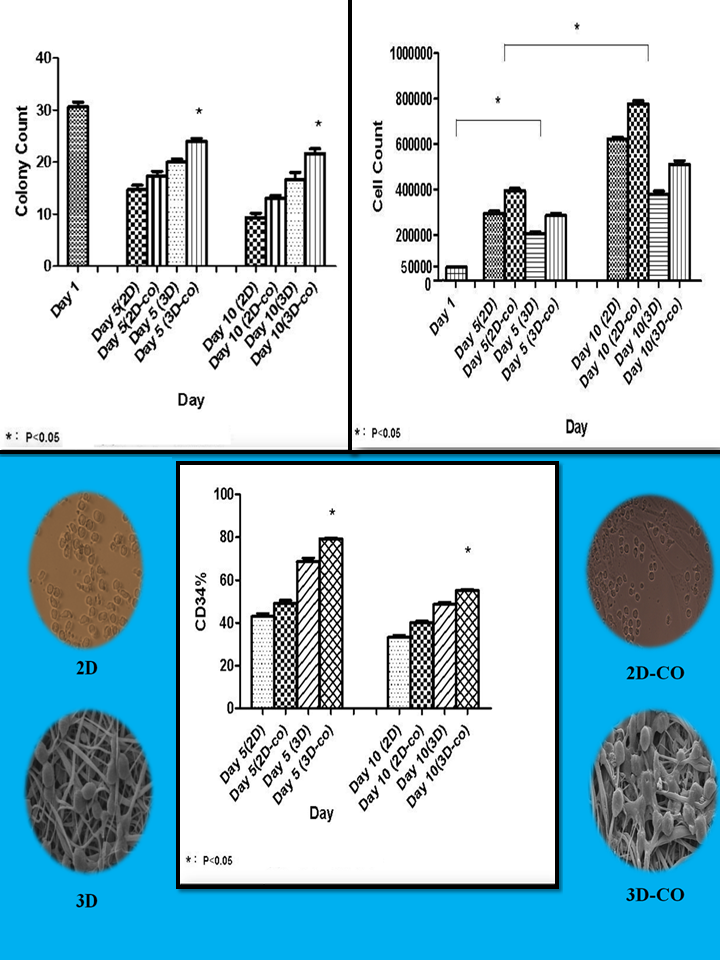hematology

Contributions
Type: Publication Only
Background
Hematopoietic stem cell transplantation (HSCT) is a therapeutic approach in treatment of hematological malignancies and inability of the bone marrow . Umbilical cord blood (UCB) known as an alternative for hematopoietic progenitor/stem cells (HPSC) for in allogeneic transplantation. The advantage of this source of HPSC is the low aptness of GVHD due to low number of T lymphocytes. The main hindrance in application of HPSC derived from umbilical cord blood is the low number of stem cells in the cord blood. So, ex vivo expansion of HSCs is the useful approach to overcome this restriction.
Aims
The aim of using this systems is to produce appropriate amount of hematopoietic stem cells, which have the ability of transplantation and long term hematopoiesis.
Methods
The routine system of hematopoietic stem cells expansion is using expansion cytokine cocktail including, SCF, TPO and FLT3L in 2- Dimensional (2D) microenvironment. In this microenvironment cells only affected by cytokines and there is not any influence of cell – cell interactions. Synthetic biomaterials such as nanofibers based on Polyethersulfone(PES) is used to produce synthetic niches. These 3D structures leads to activation of adhesion, proliferation and differentiation of CD34+cells with highly similarity to bone marrow microenvironment. Considering the important role of mesenchymal cell lineages in the bone marrow hematopoietic stem cells fate through the production of secretory factors and cell-cell interactions, in this study we used mesenchymal stem cells seeded on the bottom surface of the nanofiber scaffolds to provide their supportive role in hematopoietic stem cell proliferation during the three-dimensional culture system.Accordingly, we set up four culture systems consist of two-dimensional (2D), three-dimensional (3D),two dimensional + co-cultured by mesenchymal stem cells (2D-CO) and three-dimensional + co-culture by mesenchymal stem cells(3D-CO) . We sorted CD34+ cell by MACS technology and the cells were cultured in StemSpan serum-free medium containing SCF+TPO+Flt3L.
Results
The results of this study showed that coculture of HPSC with MSC in three dimensional scaffold could able to expand of CD34 cells with minimal differentiation in comparison to other systems.
Summary
Establishing a cell culture system with maximum similarity to the bone marrow microenvironment lead to improve culture conditions and proliferation of hematopoietic stem cells. this include three-dimensional (3D) nanofiber scaffold system and use of chemical molecules existing in matrix of bone marrow.also given important role of mesenchymal stem cells in fate of hematopoietic stem cells,using this cell resulted improved proliferation of hematopoietic stem cells.it is recommended to additional studies for more investigate the required characteristics of stem cells for bone marrow transplantation and evaluate enhanced abilities of this system.One of the challenges in this system is the harvesting hematopoietic stem cells amidst of of fiber scaffolds and mesenchymal stem cells .To overcome this problem, use of biodegradable fibers in future studies is recommended.
Keyword(s): CD34+ cells, Hematopoietic stem cell, Mesenchymal stem cell, Umbilical cord blood

Type: Publication Only
Background
Hematopoietic stem cell transplantation (HSCT) is a therapeutic approach in treatment of hematological malignancies and inability of the bone marrow . Umbilical cord blood (UCB) known as an alternative for hematopoietic progenitor/stem cells (HPSC) for in allogeneic transplantation. The advantage of this source of HPSC is the low aptness of GVHD due to low number of T lymphocytes. The main hindrance in application of HPSC derived from umbilical cord blood is the low number of stem cells in the cord blood. So, ex vivo expansion of HSCs is the useful approach to overcome this restriction.
Aims
The aim of using this systems is to produce appropriate amount of hematopoietic stem cells, which have the ability of transplantation and long term hematopoiesis.
Methods
The routine system of hematopoietic stem cells expansion is using expansion cytokine cocktail including, SCF, TPO and FLT3L in 2- Dimensional (2D) microenvironment. In this microenvironment cells only affected by cytokines and there is not any influence of cell – cell interactions. Synthetic biomaterials such as nanofibers based on Polyethersulfone(PES) is used to produce synthetic niches. These 3D structures leads to activation of adhesion, proliferation and differentiation of CD34+cells with highly similarity to bone marrow microenvironment. Considering the important role of mesenchymal cell lineages in the bone marrow hematopoietic stem cells fate through the production of secretory factors and cell-cell interactions, in this study we used mesenchymal stem cells seeded on the bottom surface of the nanofiber scaffolds to provide their supportive role in hematopoietic stem cell proliferation during the three-dimensional culture system.Accordingly, we set up four culture systems consist of two-dimensional (2D), three-dimensional (3D),two dimensional + co-cultured by mesenchymal stem cells (2D-CO) and three-dimensional + co-culture by mesenchymal stem cells(3D-CO) . We sorted CD34+ cell by MACS technology and the cells were cultured in StemSpan serum-free medium containing SCF+TPO+Flt3L.
Results
The results of this study showed that coculture of HPSC with MSC in three dimensional scaffold could able to expand of CD34 cells with minimal differentiation in comparison to other systems.
Summary
Establishing a cell culture system with maximum similarity to the bone marrow microenvironment lead to improve culture conditions and proliferation of hematopoietic stem cells. this include three-dimensional (3D) nanofiber scaffold system and use of chemical molecules existing in matrix of bone marrow.also given important role of mesenchymal stem cells in fate of hematopoietic stem cells,using this cell resulted improved proliferation of hematopoietic stem cells.it is recommended to additional studies for more investigate the required characteristics of stem cells for bone marrow transplantation and evaluate enhanced abilities of this system.One of the challenges in this system is the harvesting hematopoietic stem cells amidst of of fiber scaffolds and mesenchymal stem cells .To overcome this problem, use of biodegradable fibers in future studies is recommended.
Keyword(s): CD34+ cells, Hematopoietic stem cell, Mesenchymal stem cell, Umbilical cord blood



